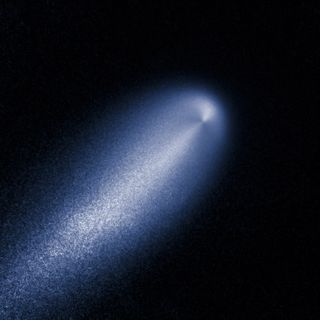
NASA's iconic Hubble Space Telescope has snapped stunning new photos of Comet ISON, which could become one of the brightest comets ever seen when it zips through the inner solar system this fall.
Hubble captured the new photos on April 10, when Comet ISON was slightly closer than Jupiter. At the time the icy wanderer was about 386 million miles (621 million kilometers) from the sun and 394 million miles (634 million km) from Earth.

The new images are already helping astronomers take a bead on the mysterious Comet ISON, which may shine as brightly as the full moon when it makes its closest pass by the sun in late November. (The comet poses no threat to Earth, NASA has said.) [Photos of Comet ISON in Night Sky]
For example, the Hubble telescope photos show that ISON is already becoming quite active, though it's still pretty far from our star. The comet's dusty head, or coma, is about 3,100 miles (5,000 km) wide, and its tail is more than 57,000 miles (92,000 km) long, astronomers said. And ISON sports a dust-blasting jet that extends at least 2,300 miles (3,700 km).
Yet the comet's nucleus is surprisingly small — no more than 3 or 4 miles (4.8 to 6.5 km) across.
This small core makes the comet's behavior on its trip around the sun, which will bring ISON within 730,000 miles (nearly 1.2 million km) of the solar surface on Nov. 28, especially tough to predict, researchers said. Also complicating the forecast is the fact that ISON is apparently making its first trip through the inner solar system from the distant, icy Oort cloud.
So it's difficult to know if ISON will live up to its billing or fizzle out like Comet Kohoutek — another possible "comet of the century" — did in 1973.
Get the Space.com Newsletter
Breaking space news, the latest updates on rocket launches, skywatching events and more!

But Comet ISON's relatively pristine state has a real upside to astronomers, who will study the material that sublimates off the comet to gain insight into its composition.
"As a first-time visitor to the inner solar system, Comet C/ISON provides astronomers a rare opportunity to study a fresh comet preserved since the formation of the solar system," Jian-Yang Li of the Planetary Science Institute in Tucson, Ariz., who led a team that imaged the comet, said in a statement. "The expected high brightness of the comet as it nears the sun allows for many important measurements that are impossible for most other fresh comets."
NASA has organized a Comet ISON Observing Campaign to coordinate the efforts of observatories on the ground and in space. Hubble is seen as a key player in this campaign, along with a number of other instruments.
Comet ISON is officially designated as C/2012 S1 (ISON) and was discovered in September 2012 by Russian amateur astronomers Vitali Nevski and Artyom Novichonok.
Hubble's new ISON photos were taken just two weeks before the telescope's 23rd anniversary. The Hubble Space Telescope, a collaboration between NASA and the European Space Agency, launched aboard the space shuttle Discovery on April 24, 1990.
Follow Mike Wall on Twitter @michaeldwall and Google+. Follow us @Spacedotcom, Facebook or Google+. Originally published on SPACE.com.
Join our Space Forums to keep talking space on the latest missions, night sky and more! And if you have a news tip, correction or comment, let us know at: community@space.com.

Michael Wall is a Senior Space Writer with Space.com and joined the team in 2010. He primarily covers exoplanets, spaceflight and military space, but has been known to dabble in the space art beat. His book about the search for alien life, "Out There," was published on Nov. 13, 2018. Before becoming a science writer, Michael worked as a herpetologist and wildlife biologist. He has a Ph.D. in evolutionary biology from the University of Sydney, Australia, a bachelor's degree from the University of Arizona, and a graduate certificate in science writing from the University of California, Santa Cruz. To find out what his latest project is, you can follow Michael on Twitter.
